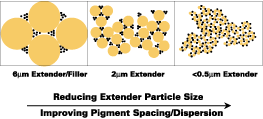
It is true to say that, over a period of 30 or so years, paint formulators have made use of smaller-particle-size extenders in their paints and significantly reduced their TiO2 content. For example, a typical high-quality matte paint of the 1970s would often contain in excess of 18% by volume TiO2. Through use of small-size calcined clay extenders, and to some degree opaque polymers, this level has now been reduced to typically between 10 and 14% by volume.
It is difficult to see how modern paints, with the already reduced TiO2 volume concentrations (vc), could continue to benefit from extender manufacturers' continuing claims of potential savings of 20 to 30% TiO2 by using their fine-particle-size extenders.
This evaluation, therefore, looks at several current fine-particle-size extenders and some "new" flash calcined extenders to see how the manufacturers' claims hold up when the extenders are used in a relatively modern paint formulation.
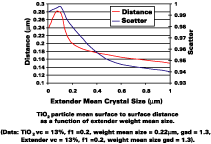
Improving TiO2 Utilization Through Improved Spacing
In decorative emulsion paints it has long been known that TiO2 pigment is often poorly dispersed and crowded by the extender and emulsion particles.1 Indeed the higher the particle volume concentration the worse the crowding can become. It is well understood that by reducing the size of the extender particles used, the spacing of the TiO2 can be significantly improved (Figure 1).
Certainly, replacing a 6æm extender/filler with a 2æm calcined clay would, and did, lead to improved TiO2 spacing, better opacity and, therefore, the possibility of reducing TiO2 levels. However, to further improve the spacing of the TiO2 to levels that could lead to significant improvements in scattering and opacity would ideally require the particle size of the extender to be an order of magnitude smaller at least. Figure 2 shows the theoretical effect on the TiO2 nearest neighbor distance when extender particle size varies from 0.01 to 1.0µm. This modeling program, developed by Temperley et al2, assumes that there is random packing between TiO2 and extender particles.
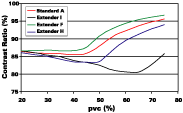
The majority of extenders that still claim to offer potential savings of 20 to 30% through TiO2 spacing are well in excess of this particle size and therefore are unlikely to be able to have such an impact on opacity using this mechanism.
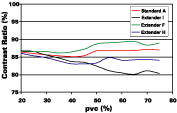
Extender Evaluation
Today the paint formulator has a bewildering choice of additives from which to choose, and the choice of extenders is no different. For this evaluation a number of leading extender manufacturers were asked to provide fine-particle-size extenders that they would recommend for improving TiO2 utilization. Table 1 lists the extenders used in the evaluation with the chemical type and particle sizes quoted by the manufacturers. Extender A, a well-known and used calcined clay extender, was selected as the standard. It is known to have improved the utilization of TiO2 when substituted for a larger, filler-type product.
To evaluate the extender performance, it was necessary to produce a PVC ladder with constant TiO2 volume concentration and varying extender volume concentration. This evaluation allowed us to determine the critical pigment volume concentration (CPVC) for each type of extender in this paint system. It would not, however, easily allow multiple extender paints to be tested, and we therefore accepted that the evaluation would be limited and that we may lose any synergistic effects (good or bad) that using extenders in combination could give.
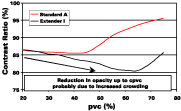
Figures 3 and 4 give examples of how three of the extenders performed in comparison to Extender A in terms of dry opacity and glycol opacity.
The use of a glycol film is to remove the effects of the increased porosity (dry hiding) and help confirm the position of the CPVC for each extender. If we consider the relationship of the curves and the CPVC levels, shown in Figures 5, 6 and 8, we can draw certain conclusions from their shape and direction. Take for example the curves for Extender A and Extender I in Figure 5. Both curves show a downward trend as the volume of extender increases, which suggests the degree of crowding is also increasing. The gradient of the decrease for Extender I is greater than that for Extender A and so it is crowding the pigment more and thus producing a more rapid fall-off in opacity. Given that the particle size of Extender I is 3.2æm this is as would be expected, since Extender A has a slightly smaller particle size and tighter distribution. By our rating method we would consider Extender I to have a worse performance and not offer any potential savings over Extender A.


The third extender is of the "new" flash calcined family. The manufacturing process produces an extender particle containing air voids (both interconnected and discrete), which are claimed to help scatter light, thus improving the opacity of the paint film. The particle size of this extender (Extender F) is very similar to Extender A and so we would not expect to gain any advantage through a reduction in pigment crowding.

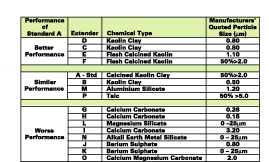
Ranking of Extenders
It is not possible to review all of the results obtained in this presentation. However, each property was carefully considered and compared to the performance of Extender A and the results used to rank the extenders in order of performance in terms of being better than, similar to or worse than Extender A. Table 2 shows the results.
From the results obtained, four extenders appeared to give an improved, and therefore potential TiO2-saving performance - extenders C and D and extenders E and F, the latter two both being flash calcined china clays. Examination of the four curves in Figure 9 shows that Extenders C and D are both gaining most of their advantage by reducing the CPVC of the paint, although small increases in opacity below the CPVC are also evident.

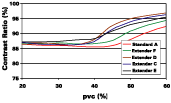
TiO2 Reductions
In order to determine how much TiO2 could potentially be saved and to determine what, if any, detrimental effects this would have on the other paint properties, a series of paints were made with incremental reductions in TiO2. As shown in Figure 10, a PVC of 30% was chosen for the evaluation as this was below the CPVC, thus avoiding complications of dry hiding, and also showed a substantial improvement in opacity over Extender A. Figure 11 gives the opacity results obtained for a given reduction in TiO2vc.As can clearly be seen, a reduction in TiO2vc of 20% is possible if a match in opacity is required. If, however, we consider the reflectance over black, as in Figure 12, we see that the equivalent reflectance is at a slightly lower saving of between 10 and 15% TiO2vc. This also suggests that some of the opacity advantage exhibited by Extender E (and F) is coming from absorption rather than scattering.
Wet opacity is of less importance than it once was and, as one would expect, a reduction in TiO2 loading results in a decrease in the wet opacity. Indeed, only the smallest level of TiO2 reduction could be made without a significant decrease in wet opacity (Figure 13).

The presence of greater porosity in the paint with Extender E was confirmed by the use of Mercury porosimetry. While not completely ideal for assessing the total porosity of paint films, the method does appear to work well in systems where any voids are likely to be interconnected rather than discrete. Figure 14 shows the plot from Mercury porosimetry for paints with Extender A and Extender E.
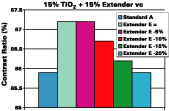
Given that we had identified the existence of greater porosity in the Extender E paint film we examined the level of scrub resistance to see if there were any adverse effects in reducing the TiO2 level and replacing it with extender. Figure 15 shows the results obtained. In Figure 15 it can be seen that simply exchanging Extender A for Extender E has led to a slight decrease in scrub resistance. On reducing the level of TiO2 and replacing it with Extender E, the scrub resistance continues to fall and fails the requirements of <5mg/cm2 loss when more than 5% TiO2vc is replaced. This again falls well short of the claimed 30% saving in TiO2.
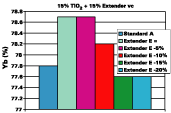
The Effect of Entrapped Air on TiO2 Utilization
As we have discovered so far, the use of fine-particle-size extenders can help to improve the TiO2 utilization in emulsion paints, although the levels of 20 to 30% claimed by the manufacturers are currently only possible at the expense of other paint properties. We have seen how flash calcined extenders with their air void structures can improve the opacity of emulsion paints through some additional scattering, although we have shown that the majority of the voids are not of a suitable size to preferentially scatter light. This suggests that there is another component in the equation that is adding to the opacity of the paint and is imparted by the extender.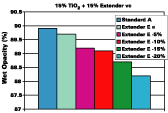
Alkyd resins have a typical refractive index of around 1.51, while an acrylic emulsion will be slightly lower at approximately 1.48. By modeling the scattering power of TiO2 as a function of resin refractive index (RI) we can show that this small difference of 0.03 units in RI is sufficient to produce an uplift in opacity of 0.5 units contrast ratio. It can also be shown by simple calculation that a level of 5% air, entrapped within the paint film, will approximately account for a similar reduction in refractive index and thus increase opacity.
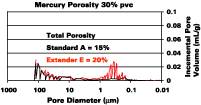
If, on the addition of certain extenders, more air is entrapped within the paint, then this would have the effect of reducing the perceived refractive index of the paint medium and thus increase the opacity of the paint. It is this process that we believe is contributing to the opacity advantage seen when using Extender E.
Further work is now being undertaken at Huntsman Tioxide to better determine the levels of air entrapped in emulsion paints, the "particle size" of the air voids, how these interact with the paint film and how, if at all, it is possible to control the inclusion of air in the paint.
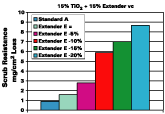
Conclusion
Having evaluated a range of fine-particle-size extenders we have concluded that some small improvements in TiO2 utilization are still possible using these products, although the claims of 20 to 30% saving in TiO2 could not be fully substantiated when all of the major paint properties were considered. Current extenders with a particle size in excess of 0.5µm have been shown, both theoretically and through experimentation, not to improve the spacing of TiO2 and thus will not improve the TiO2 utilization by this method. Those extenders with particle sizes of less the 0.5æm were not easily dispersed down to their primary size and tended to homo-flocculate, creating large, multi-particle extenders causing increased crowding and lower opacities.
The use of flash calcined china clays did appear to offer better TiO2 utilization, but again when other paint properties were included the benefits achieved were markedly reduced. The incorporation of air voids within the paint film by these extenders was shown to have a positive effect on opacity, although the size of the voids suggest that light scattering may not be the principle method by which the improvement in opacity is achieved. The inclusion of air voids is thought to reduce the apparent refractive index of the medium and this reduction is contributing to the increase in scattering of the TiO2 pigment.
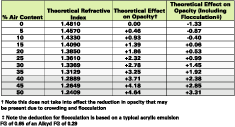
Acknowledgements
The author would like to express his thanks to Dr. Les Simpson, John Temperley, Kathryn Fullerton and Frank Holden for their help in preparing this paper and carrying out the necessary laboratory work. I would also like to thank Mahomed Maiter, Group Marketing Director and Brian Thomas, Group HR & Communications Director, for their support in publishing this paper.
For more information, contact Paul Dietz, Huntsman Tioxide, Haverton Hill Road, TS23 1 PS, Great Britain; phone 0044 1642 376467; fax 0044 1642 676777; e-mail paul_f_dietz@huntsman.com.
References
1 Cutrone, L; and Becherel, D. Interaction Between Fine Particle Extenders and Titanium Dioxide in Paints; Technical Report D9202GC; Huntsman Tioxide.2 Temperley, J; Westwood, MJ; Hornby, MR; Simpson, LA. Use of a Mathematical Model to Predict the Effects of Extenders on Pigment Dispersion in Paint Film. J. Ctgs. Tech., 1992, Vol. 64 No.809, 33-40.
This paper was presented at the 7th Nurnberg Congress, European Coatings Show, April 2003, Nurnberg, Germany.

Report Abusive Comment